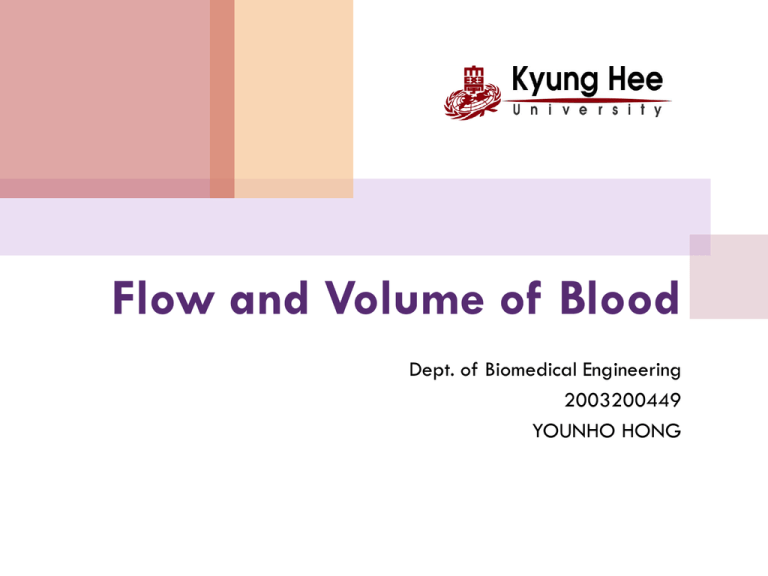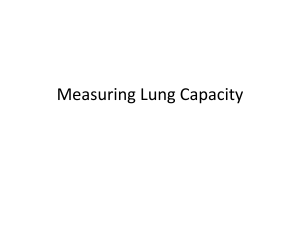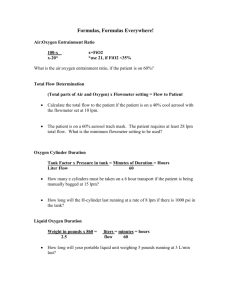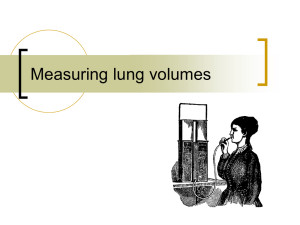Flow and Volume of Blood
advertisement

Flow and Volume of Blood Dept. of Biomedical Engineering 2003200449 YOUNHO HONG Contents Cardiac Output - Fick - Indicator Dilution - Thermo Dilution Electromagnetic flow meter Ultrasound flow meter - Transit time - Continuous Doppla - Pulsed Doppla - Thermal Convection Plethysmography Indicator Dilution and Fick Method # Indicator Dilution Fi Ci F : flow C : concentration The unit of blood flow : l/min or ml/s Fo Co dm (infusion rate) dt Mass Balance Equation The quantity of in and out is the same, and there is no leakage. dm Ci F Co F dt # Fick dm F dt C o Ci dm : O2 consumption, L/min ( measured by spirometer) dt Co = Ca : concentration in artery Ci = Cv : concentration in vein dm F dt C o Ci Indicator Dilution ( Dye dilution Method) c(t) indicator dilution curve recirculation bolus injection Extrapolation dm C (t ), dv T dm C (t ) dv , dm C (t ) F dt T 0 t T dm F C (t ) dt m 0 Use Cardio green or Indocyannine green for a dye. dm dv C (t ) C (t ) F dt dt F m T 0 C (t ) dt Thermo-dilution c(t) T Use cold saline(4˚C) bolus injection t F Q t1 b cb Tb (t )dt [m3 / s] 0 Q Vi Ti i ci heat contentof injectate,[J] b blood density,[kg/m3 ] cb specificheat of blood,[J/kg K] Ultra Sound Primary echo is bigger than secondary echo. t ultra-sound generator skin Transit time flowmeter velocity of ultra sound μ c D θ (1) down-stream td velocity of RBC, WBC and platelit D c cos (2) up-stream D tu c cos D D c cos c cos 2 D cos 2 D cos 2 2 2 c cos c2 t tu t d (c 2 2 cos2 ) Doppler flowmeter (1) Continuous Doppler flowmeter (cf) Radar system fo, c f+fd, c object u c 3 108 m / s fd u fo c (2) Pulsed Doppler flowmeter u1 f u2 u2 u1 u3 T fd1 fd3 fd1 fd2 fd2 t x Thermal convection flowmeter Thermister F T2 Invasive, probe positioning is difficult. The stronger F gets, The sharper the temperature of T2 is decreased. (1) Bios current => Thermister heating (2) T2 Thermister is cooled by thermal convection. (cf.) respiratory monitoring by thermister Temp. of inspiration is 25˚C. Temp. of expiration is 36.5˚C. Plethysmography leg open artery close vein cuff Z(V) i V toes normal slope = flow(in artery) slope = flow(in vein) cuff dv f ( flow) dt cuff off Venous Thrombosis t Respiratory System # Architecture Tracher velocity uT A T Q uT AT u A AA air flow Bronchas [l/min or ml/s] cross-sectional area The total of volume flow is not changed. … Alveoli uA AA # Physiological functions - O2 transport into blood stream - CO2 removal from blood stream - Homeostasis of PH, PO2, PCO2 AT u A uT uT AA velocity of the air at alveoli is almost zero. # Respiration - Ventilatory mechanics => RC equivalent circuit model - Gas transport => Mass balance equation (Diffusion process) Pressure measurement (1) Differential pressure transducer diaphragm P1 P2 diaphragm strain gage (2) Balloon Sensor Vi hole P gas ballon 0V : switch on => P>Pi 5V : switch off => P<Pi metal switch +5V pressure sensor P Pi air pump MP control pressure (Pi) Flow measurement (1) (2) (3) (4) Rotating vane Ultrasound flowmeter Thermal convection Pneumotachometer # Pneumotachometer P1 P1 P2 R Q P2 measurement Q (flow) mouth mesh screen resistance P1 P2 Q (Calibratio n) R Volume measurement (1) Water spirometer single turn potentimeter vital capacity air TLC pen IC water FRV Vc TV ERC Rv CO2 absorber mouth (2) Dry spirometer mouth expiratory gas (empty) inspiration gas valve pistol change the position of the pistol during breathing. FRC measurnment (1) He Dilution technique - Patient at FRC - Prepare a spirometer of volume Vsp and imitial He Concentration of FIHe - Patient breaths Fb the spirometer - Find He concentration of expiratory gas FIHe Vsp FI He (Vsp FRC) FI He FRC FI He FFHe FFHe Vsp FRC measurnment (1) N2 washout technique - Patient at FRC - Prepare a spirometer with O2, Vsp - Patient breaths to the spirometer - Measure N2 concentration in the expiratory gas 0.8 FRC (FRC Vsp ) FFN2 Gas concentration measurement (1) Mass spectroscophy (2) Gas chromatography (3) Infrared spectroscophy (4) Ramen spectroscophy (5) Emission spectroscophy (6) Paramagnetic O2 analyzer Gas transport measurement (1) Gas distribution test => single breath N2 washout - RC => TLC O2 inspiration - pause (hold breath) - Expiration and measure FN2 (2) Diffusion test => CO diffusion capacity - Inspire CO, He in the air to TLC from RC - Hold breath for 10sec - Expire to measure FFCO and FFHE DCO FI CO FFHe 60U A ln[ ] t ( PB 47) FFCO FI He Thank You.









